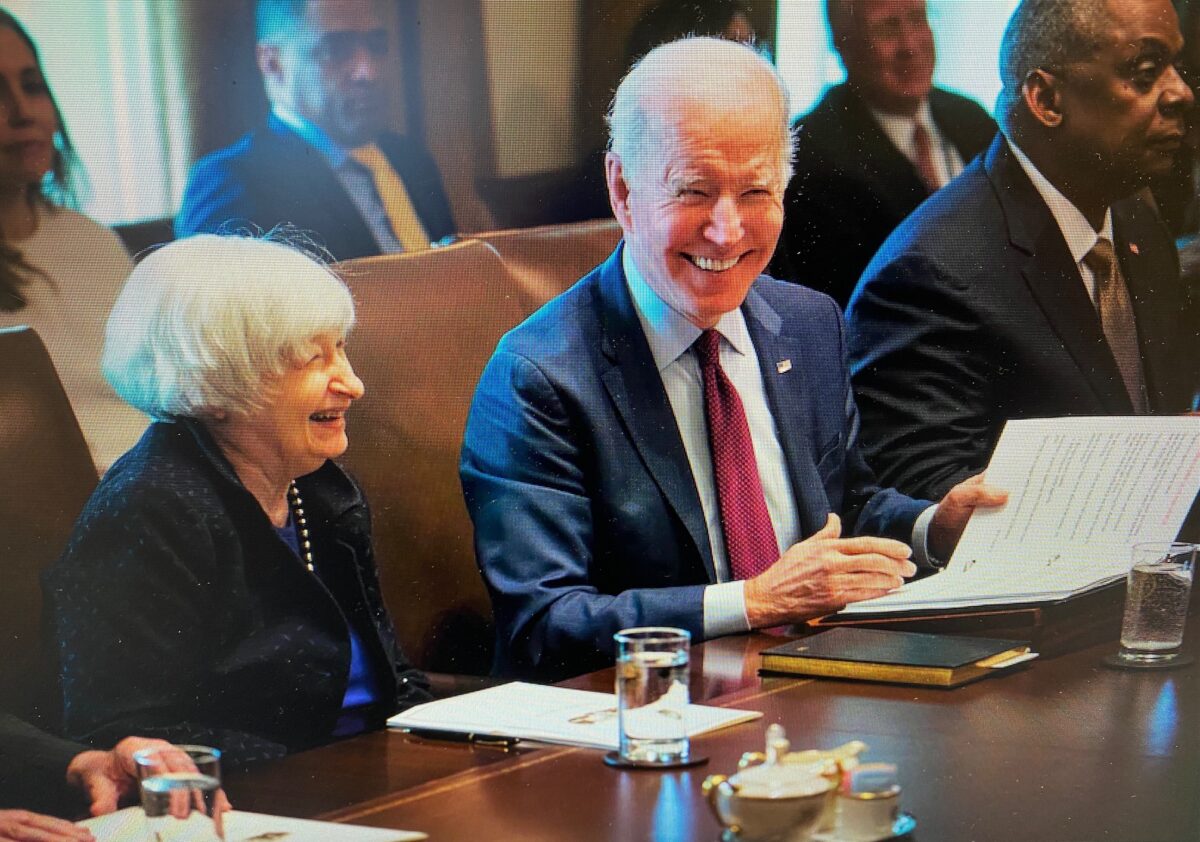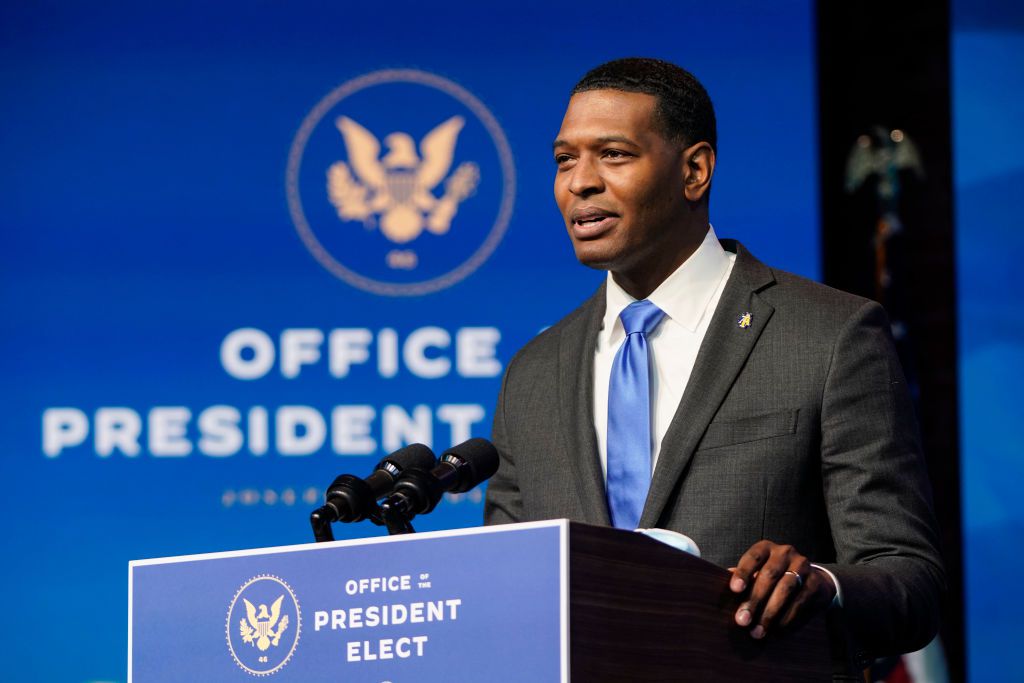Budget Includes Increases for National Park Service, EPA –

OMB Director Shalanda Young with President Biden introducing the budget proposal for the fiscal year that begins in October: NAJ Screen shot
Staff Report –
WASHINGTON, D.C. — It’s hard to remember a time when a president’s budget plan was greeted with more enthusiasm than the $5.8 trillion budget proposal issued by the Biden Administration on Monday. The last time this happened was probably 1999, in Bill Clinton’s last year as president, when the federal budget deficit had been erased and a “peace dividend” was announced.
Depending on how things go in negotiations with Congress, this could help boost the chances that Democrats might hold off Republican challenges in the midterm elections in November in the House and Senate.
“We’re making real headway cleaning up the fiscal mess I inherited,” Biden said when introducing the budget on Monday. “We’re returning our fiscal house to order.”
The Trump administration had gutted the federal government with hiring freezes and ballooned the deficit with tax cuts.
The Biden-Harris budget document includes a host of new tax hikes on the rich and corporations that will make Democrats, liberals and progressives cheer and crow on social media, but also appeal to moderates like West Virginia Senator Joe Manchin, concerned about inflation and deficits.
It’s unclear how this will be welcomed in the current Congress, and Republicans are sure to fight it for political purposes.
But among the new tax measures incorporated into the budget is a “Billionaire Minimum Income Tax” that would levy a 20 percent minimum tax on all income, including unrealized capital gains, for Americans with assets worth more than $100 million.
The proposed budget includes about $2.5 trillion in new tax revenue, with about $1.5 trillion in new spending and the rest dedicated to deficit reduction, some of which would be accomplished by reining in future borrowing. The proposal would reduce the national budget deficit by roughly $1 trillion over 10 years, if agreed to by Congress.
“While the debt would continue to grow even if all of the administration’s proposals are enacted, the White House document reflects a new focus on fiscal prudence,” according to The Washington Post’s breaking news coverage.
Last year, the White House budget would have increased the nation’s deficits over 10 years by almost $1.4 trillion. The 2023 budget sets out to reduce the annual deficit every year for the next 10 years.
Some of the emphasis on deficit reduction comes from the outsized role now being played in Washington by Manchin, who The New York Times just excoriated in a new investigative report about how he made a fortune by using his political influence in his private business practice by pushing dirty coal.
NYT: How Joe Manchin Aided Coal, and Earned Millions
Manchin has repeatedly emphasized his interest in a budget deal that would reduce the nation’s fiscal imbalance and combat inflation. Reducing government borrowing in the long term may help allay those concerns ahead of the 2022 midterm elections, The Post reports.
“Biden’s push on deficits could pose a political challenge to the Republican Party, which has traditionally modeled itself (falsely) as more fiscally responsible than the Democratic Party,” The Post reports. “Both of the past two Republican presidents, George W. Bush and Donald Trump, oversaw enormous increases in the federal debt during their administrations. And the Republican Party has resisted releasing its own economic blueprint for America, with Senate Minority Leader Mitch McConnell (R-Ky.) rebuffing members of his own party for attempting to craft a policy vision for the 2022 midterms.”
In announcing the new budget, President Biden touted a “new economic vision” to meet the challenges and seize the opportunities of this “decisive decade.”
“We are competing with China from a position of strength, while leading a global coalition united in condemnation of Russian aggression against Ukraine. We are tackling the climate crisis with urgency, strengthening the global health architecture to combat COVID-19 and future pandemics, and enhancing cybersecurity and addressing emerging cyber threats,” the president said. “We are joining with allies and partners to write the rules of 21st Century economics, trade, and technology.”
He also said the budget would fight inflation by reducing costs for families, slow the growth of the deficit, and “build a better America.” The “Build Back Better” slogan has been dropped by this administration.
National Park Service
Nowhere was the president’s budget plan greeted with more enthusiasm than the National Park Service, where the Biden-Harris administration’s proposal includes a vision to expand on the historic progress made over the last year and deliver the agenda from the State of the Union address, “to build a better America, reduce the deficit, reduce costs for families, and grow the economy from the bottom up and middle out.”
The proposed federal spending plan includes a $3.6 billion budget for the National Park Service for Fiscal Year 2023, an increase of $492.2 million compared to an FY 2022 Continuing Resolution.
It prioritizes equity and inclusion, climate science and resiliency, infrastructure needs such as bandwidth improvements and addressing deferred maintenance, the park service said in a press release prepared in haste on Monday.
“Increasing or restoring park capacity is consistent across these initiatives,” the park service said. “The budget makes critical investments in the American people that will help lay a stronger foundation for shared growth and prosperity for generations to come.”
“The 2023 budget demonstrates a commitment from the Biden-Harris Administration to address critical issues of our time,” said National Park Service Director Chuck Sams. “The National Park Service plays an important role in connecting Americans to our interwoven history, culture, and environment. This funding is essential to help us continue to improve vital infrastructure, increase equity and inclusion, and tackle the climate crisis.”
Dozens of National Park Service programs, highlighted below, provide financial and technical assistance to partners and communities that support conservation, education and preservation activities outside of national park boundaries.
The FY 2023 NPS budget proposes targeted increases of $48 million service wide to advance racial justice and equity for underserved communities. Many of the newest additions to the National Park System preserve the stories of under-represented communities, and the FY 2023 budget requests new funds to support their operations, including Medgar and Myrlie Evers Home National Monument, Camp Nelson National Monument, and Pullman National Monument. Programs such as the African American Civil Rights Network, Underground Railroad Network to Freedom, and Tribal Heritage grants reflect this commitment.
The additional $48 million requested in the budget includes:
* $14.3 million for operational increases at parks that preserve the stories of under-represented communities, including many of the newest parks.
* $5 million to support African American Civil Rights Network partnerships.
* $5.7 million to increase capacity at parks and central offices to strengthen partnerships and improve coordination with Tribes.
* $8 million for grants to Tribal Historic Preservation Offices.
* $5 million to improve park accessibility by implementing an interdisciplinary network support model, including facility access, accessible programming, recreational experiences and technology.
* $5 million to address transportation barriers to parks from underserved communities.
* $5 million for large-scale competitive African American Civil Rights historic preservation grants.
Conservation Initiative
Stewardship of natural and cultural resources is a mission critical task for the National Park Service. With targeted increases of $227.6 million, the budget seeks to bolster existing successful programs that protect wildlife and landscape, fund climate change science and resiliency, and increase resources supporting science-based climate and natural resource decision making.
An important component to tackling the climate crisis is the Biden-Harris Administration’s goal to conserve 30 percent of the nation’s lands and waters by 2030.
In total, the budget requests an increase of $227.6 million to support climate-related needs, including:
* $57 million to increase park natural resources operational capacity.
* $29.6 million to complete natural resource projects, such as wildlife migration corridors, wildland fire fuels management, and responding to natural resource threats.
* $31 million to establish a Civilian Climate Corps.
* $17 million for Research Learning Centers that facilitate the use of parks for scientific research, share knowledge, and support informed decision making.
* $16 million for the Inventory and Monitoring Program that tracks key park resources.
* $10 million increase for abandoned mineral lands projects.
* $5.5 million for Cooperative Ecosystem Studies Units which bring together scientists, managers, students, and others to conduct interdisciplinary projects.
* $3.7 million to create an interdisciplinary team to design and conduct inventory and monitoring of cultural resources impacted by climate change.
* $3.5 million for the Socioeconomic Monitoring program to improve understanding of the demographics and behaviors of visitors.
Addressing Infrastructure and Construction Needs
Significant investment is needed in national park infrastructure to provide safe and quality experiences for hundreds of millions of visitors each year, the park service says.
Multiple funding sources are part of a concerted effort to address the extensive maintenance repair backlog in national parks.
The existing network of roads, trails, restrooms, campgrounds, water treatment systems, and visitor facilities are aging, and many exceed the capacity for which they were designed.
A new facility condition assessment methodology will provide a more streamlined, comprehensive, consistent, and timely identification of repair needs estimates.
The budget provides:
* $959 million for Facility Operations and Maintenance, including $136 million for repair and rehabilitation projects and $188.2 million for cyclic maintenance projects.
* $6.9 million to address increase leased and owned housing supply for NPS employees.
* $279.3 million to fund construction projects, equipment replacement, management, planning, and special projects. This includes $120.7 million for line-item construction.
* $6.9 million to make incremental improvements to NPS bandwidth and network capacity, including last-mile connections and other infrastructure improvements.
Operations
The request continues the commitment to the daily mission of providing enriching experiences for the public in every national park. There are multiple requests across initiatives and functional areas to build or restore operational capacity.
Significantly, the budget request increases would support more than 1,400 additional full time equivalent employees to strengthen critical functions at parks, including dedicated increases for telling under-represented stories at some of the newest parks, increasing natural resources management capacity to ensure parks are prepared to manage through climate change, restoring law enforcement capacity to the U.S. Park Police, and a general capacity increase of $30.8 million that would benefit all parks.
The National Park Service maintains and preserves 423 national parks, 23 national scenic and national historic trails, and 64 wild and scenic rivers. These places of natural and historic significance provided inspiration and recreation for almost 300 million visitors last year and are economic engines for nearby communities where $14.5 billion in sales supported 234,000 jobs, generating $9.7 billion in labor income, $16.7 billion in economic value added, and $28.6 billion in total economic output.
Environmental Protection Agency
The Environmental Protection Agency was also quick to praise the budget plan and issue a statement.
The budget makes historic investments to advance key priorities in the FY 2022-2026 EPA Strategic Plan, including tackling the climate crisis, advancing environmental justice, protecting air quality, upgrading the nation’s aging water infrastructure, and rebuilding core functions at the agency (gutted by the Trump administration).
“The President’s budget request for EPA reflects this administration’s unwavering commitment to protect people from pollution, especially those living in overburdened and underserved communities across America. It funds a broad suite of transformational programs enacted by the Bipartisan Infrastructure Law, and it will enable us to implement the President’s historic Justice40 commitment, among other key priorities,” EPA Administrator Michael S. Regan said in a press release.
“Almost half of the Budget announced today, $5.7 billion, will support Tribes, states, and localities, reaffirming EPA’s commitment to work in concert with our partners and local communities to tackle the climate crisis and ensure that no American family has to worry about the air they breathe, the water they drink, or the environmental safety of their homes and workplaces,” Regan said. “The budget makes critical investments in the American people that will help lay a stronger foundation for shared growth and prosperity for generations to come.”
At the EPA, the Budget invests in:
Upgrading Drinking Water and Wastewater Infrastructure Nationwide
The budget provides approximately $4 billion to advance efforts to upgrade drinking water and wastewater infrastructure nationwide, with a focus on underserved communities. It would fund 20 new targeted water grant programs authorized in the Drinking Water and Wastewater Infrastructure Act (DWWIA).
In total, more than $940 million in new resources are provided to implement DWWIA in FY 2023.
The budget also supports water infrastructure with an increase of $160 million in grants to reduce lead in drinking water and an increase of $240 million for the Sewer Overflow and Stormwater Reuse grant program.
It proposes a new $25 million water sector cybersecurity grant program. The budget also maintains funding for the State Revolving Funds, which will complement the $23.4 billion provided for the traditional SRF programs over five years in the recently enacted Infrastructure Investment and Jobs Act.
Ensuring Clean and Healthy Air for All Communities
The budget allocates $1.1 billion to improve air quality and reduce localized pollution, reduce exposure to radiation, and improve indoor air for communities across the country. This includes $152 million to support the development and implementation of national emission standards to reduce air pollution from vehicles, engines and fuels.
It also supports $299 million to assist air pollution control agencies in the development, implementation, and evaluation of programs for the National Ambient Air Quality Standards (NAAQS) and to establish standards for reducing air toxics.
Tackling the Climate Crisis
The budget prioritizes funding for tackling the climate crisis and invests an additional $100 million in grants to Tribes and states that will support on-the-ground efforts to reduce greenhouse gas emissions and increase resiliency in the Nation’s infrastructure.
It proposes an additional $35 million to implement the American Innovation in Manufacturing Act to continue phasing out potent greenhouse gases known as hydrofluorocarbons and invests an additional $13 million in wildfire prevention and readiness.
Advancing Environmental Justice
“The administration is committed to increasing efforts to deliver environmental justice in communities across the nation,” the EPA says.
The budget supports the President’s Justice40 commitment to ensure at least 40 percent of the benefits of federal investments in climate and clean energy reach historically overburdened and underserved communities.
It invests more than $1.45 billion across the agency’s programs that will help create good-paying jobs, clean up pollution, advance racial equity, and secure environmental justice for all communities.
To elevate environmental justice as a top agency priority, EPA has proposed a new national environmental justice program office, to coordinate and maximize the benefits of the Agency’s programs and activities for underserved communities.
Protecting Communities from Hazardous Waste and Environmental Damage
Preventing and cleaning up environmental damage that harms communities and poses a risk to public health and safety continues to be a top priority for the administration.
The budget provides $1.15 billion for EPA’s Superfund programs to continue cleaning up some of the nation’s most contaminated land and respond to environmental emergencies.
It also includes $215 million for EPA’s Brownfields programs to provide technical assistance and grants to communities, including overburdened and underserved communities, so they can safely clean up and reuse once contaminated properties, and it supports additional Community Development Specialists to manage land revitalization projects and works with Tribal, rural, and overburdened and underserved communities to address brownfields.
Strengthening Our Commitment and Ability to Successfully Implement Toxic Substances and Control Act
The budget provides $124 million and 449 FTE for TSCA efforts to deliver on the promises made to the American people by the bipartisan Lautenberg Act.
These resources will support EPA-initiated chemical risk evaluations and protective regulations in accordance with statutory timelines.
Tackling Per- and Polyfluoroalkyl Substances Pollution
PFAS are a group of man-made chemicals that threaten the health and safety of communities across the nation. As part of the President’s commitment to tackling PFAS pollution, the budget provides approximately $126 million in FY 2023 for EPA to increase its understanding of human health and ecological effects of PFAS, restrict uses to prevent PFAS from entering the air, land, and water, and remediate PFAS that have been released into the environment. EPA will continue to act on the Agency’s PFAS Strategic Roadmap to safeguard communities from PFAS contamination.
Enforcing and Assuring Compliance with the Nation’s Environmental Laws
The budget provides $213 million for civil enforcement efforts, which includes increasing enforcement efforts in communities with high pollution exposure and to prevent the illegal importations and use of hydrofluorocarbons in the U. S. It also includes $7 million to operate a coal combustion residuals compliance program, $148 million for compliance monitoring efforts, and $69 million for criminal enforcement efforts, including the development of a specialized criminal enforcement task force to address environmental justice issues in partnership with the Department of Justice.
Restoring Critical Capacity to Carry Out EPA’s Core Mission
The budget includes more than 1,900 new Full Time Equivalents relative to current levels, for a total of more than 16,200 FTEs, to help rebuild the agency’s capacity. Restoring staffing capacity across the agency will facilitate and expedite EPA’s work to reduce air, water, and climate pollution and advance environmental justice.
The budget continues to strengthen the agency’s ability to recruit, hire, develop, promote, and retain top talent and remove barriers to equal opportunity at the management and staff levels in order to strengthen and advance diversity, equity, inclusion, and accessibility.
“The budget makes these smart investments while also reducing deficits and improving our country’s long-term fiscal outlook,” the agency says.
Others React
House Majority Leader Steny Hoyer, a Democrat from Greenbelt, Maryland, released a statement Monday on President Biden’s Fiscal Year 2023 discretionary budget proposal.
“The President’s Fiscal Year 2023 budget aims to take advantage of opportunities created by the fastest-growing economy in decades to make fiscally responsible investments that sustain our recovery over the long term and help our businesses and workers make it in America,” Hoyer said.
“It will strengthen our national security while supporting Ukraine, sharpen our global competitiveness edge against China, expand our supply chains to promote domestic manufacturing, provide resources to ensure every American can live in a safe community, increase the supply of affordable housing, make college more affordable, and expand treatment for mental health and maternal healthy” he said.
“At the same time, the President’s budget would reduce deficits by more than $1 trillion over the next decade, in part by requiring billionaires to pay their fair share toward building a better and stronger America.”
This budget proposal reflects President Biden and Democrats’ determination to chart a path forward for America that sets up the next generation for economic security and success as well as global leadership, Hoyer said.
“I look forward to reviewing all the details with my colleagues as the House prepares its Fiscal Year 2023 appropriation bills, and I commend OMB Director Shalanda Young and her team for all their hard work. This is truly a budget For the People.”
___
If you support truth in reporting with no paywall, and fearless writing with no popup ads or sponsored content, consider making a contribution today with GoFundMe or Patreon or PayPal.















